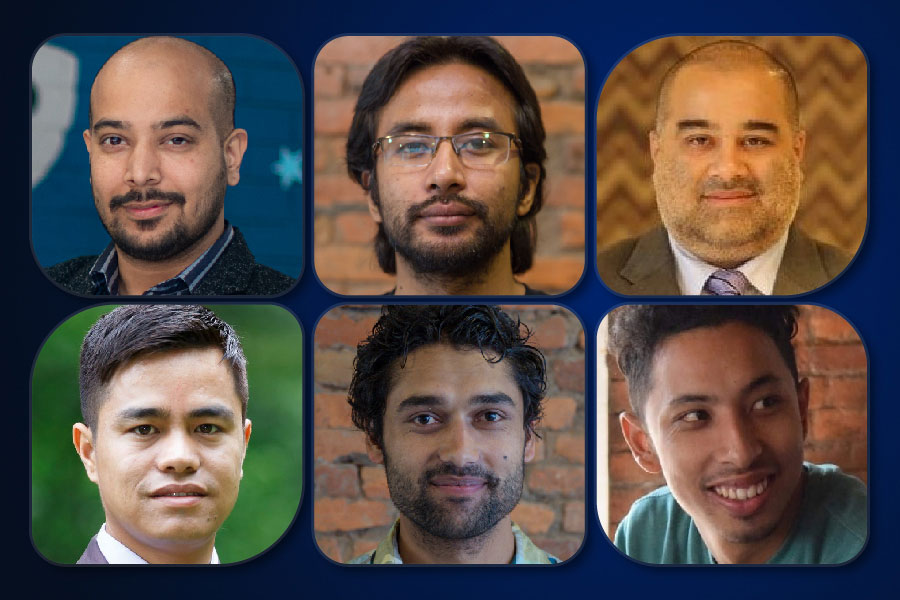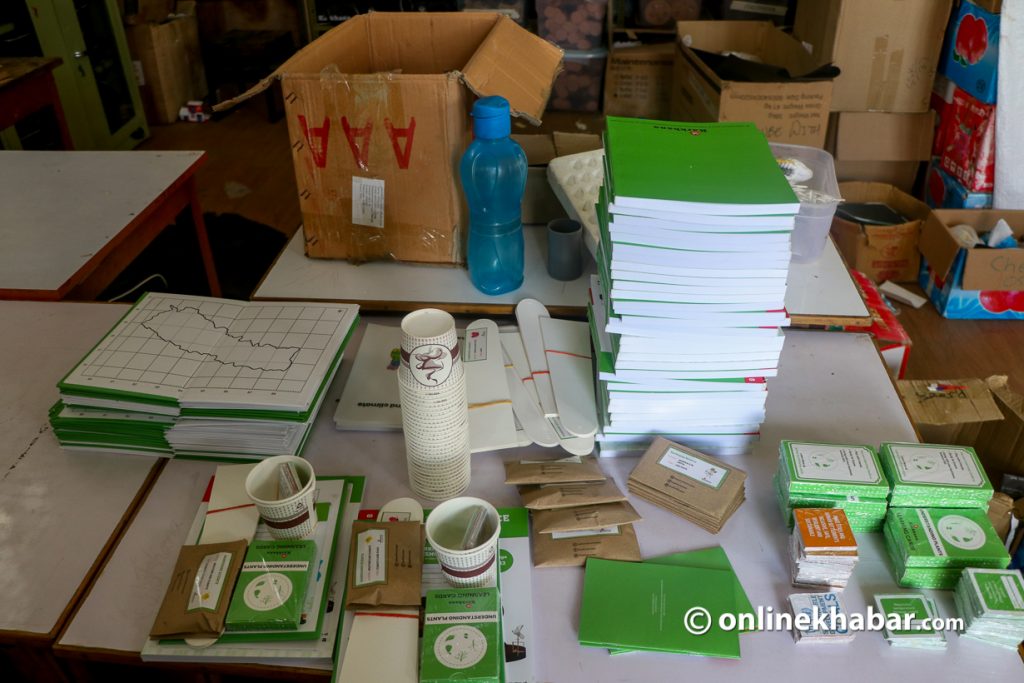All the academic institutions across the country are closed as of now and have reached a state of downfall financially. However, even in such circumstances, inside a three-storey building in Gyaneshwar of Kathmandu, some youth are busy making and packaging ‘Science Kits’ to teach new knowledge and skills to students.
On the first floor, some people are seen making electric goods while some are designing, and some doing research. And, the second and third floors are filled with small bags, where experimental materials designed using science and technology, targeting the students of grades six to eight, are kept.
These materials in the bag will help the students learn creative skills in subjects of students’ interest such as gaming, robotics, animation, and craft that address, they claim.
People behind this initiation are engineers Pabitra Gautam, Sunoj Das Shrestha, Suresh Ghimire, Sakar Pudasaini, Divyeshwar Man Shrestha, and Sachet Manandhar. They started this research company called Karkhana eight years ago with an aim of doing something new in the field of science and technology. This company invents creative ways and shows them to teach students to use science and technology in a modern way, explains the Karkhana team.
Bridging the gap between knowledge and skills
What the Karkhana does today is not what it used to do earlier, or at least intend to do in the beginning. “When Karkhana was started, we had no intention of working in the education sector. We worked for the companies that came to us as per their products,” recounts Gautam, a co-founder and chief executive officer (CEO) of the company.
In the beginning, all the co-founders distributed responsibility among themselves while opening this company. Ghimire and Shrestha duo took the charge of designing the subject matters relating to the academic field while Gautam took on the responsibility of market management and public relations. And, Manandhar took care of the financial and legal management of the company, they say.
Further, he elaborates, “We initially worked for Gham Power company. We made remote controlling systems and solar connecting systems which became very popular. We also built a vending machine for eSewa at that time.”
During that course of time, the team shares, they had to make a spring for the vending machine. But, it was not easy for them to prepare that spring. They went to many stores and tried to get materials to make a spring as they wanted but could not get it made in an engineering way.
Gautam says, “Then, we went to the CTEVT to get training for making the spring needed for the vending machine. There we learned to operate a lathe machine.”
After that, the team realised that there was a huge gap to fill in Nepal. That gap was the gap between an engineer and a contractor, that is, the engineer who drives the brain and the contractor who is responsible for making it, Gautam says, adding unless these two are coordinated, there can be no development of innovation.
Gautam remembers, “Then, we also started working on that concept for bridging that gap and that changed our way of thinking. In this effort, we enrolled engineering undergraduate, graduate, and school students in various engineering colleges’ projects.”
This effort again revealed one more thing that concretised their idea. They found that school students were better than college students in terms of innovation and expressiveness. Then, they decided to focus on schools.
“The concept of education in Nepal is to study from 1st to 10th classes, bachelor’s and master’s and then it is over, it does not really matter whether the student learns. Given that, some even leave their education halfway, but students cannot recognise the talent and ability within themselves.”
“Addressing these traits of the students and challenges in the educational system in Nepal, we started making learning materials for experimental practice based on the school curriculum,” opens up Gautam.
Hurdles to tackle

For two years after its establishment, all the Karkhana’s team members had to work without pay. Gautam reveals most of their time was spent researching the school course and designing products to match that. Later, for the sustainability of the company, they used to work on a project from which they used to earn about Rs 25,000 a month.
According to Gautam, they used to divide their earnings among each of them individually, and each ould get Rs 2,000 to Rs 3,000. “At that time, we chose skills over money. Not only that, we limited ourselves to a small room,” he says, “Gradually, we started running educational workshops. This teaching and learning process also brought us closer to the schools and the students. We came together to prepare experimental materials for science.”
The main product: Science Kit

Before making experimental learning materials for the students, the team also studied a one-year BEd course to get ideas about the principles of education. In addition, the company also conducted workshops with science teachers from different schools, asked for suggestions for making the content of the course effective, and also carried out practical exercises for its implementation, according to Gautam.
But in the meantime, the Covid-19 pandemic hit Nepal, thus, schools and colleges were closed in an effort to combat the spread of the pandemic. So, the company introduced a science kit for students of grades six to eight.
Karkhana’s Science Kit, brought to the students for an experimental and practical learning experience, contains many commonly used threads, scissors, tapes, small pipe pieces, and digital guide books, which can be used by sixth to eighth graders, explains Gautam.
For the students of class 6, the kit has filters, a colour palette, litmus paper, and other equipment that can be used for studying pressure, heat, light, and chemistry in their course. The kit also consists of wooden pieces to showcase to the students the orbiting of the earth, moon, and the sun in an experimental way, a map board that helps students get information about the weather, soils, rocks, and other geographical things found in different places.
Besides, the Karkhana team has designed the Science Kit in such a way that the students can repair the kit at their homes if they break down. For this, they provide a notebook along with a kit.
According to Samaya Khadka, the product manager of the company, 33 experimental materials have been kept for grade six, and a kit is priced at Rs 5,300. Likewise, the grade-seven and grade-eight kits cost Rs 5,400 and Rs 5,700 respectively.
Like grade-six science kits, the kits for grades seven and eight are also designed incorporating the course’ subject matters which the students can easily learn through experimental and practical ways using the materials such as dynamos, screws, pieces of acrylic, electronic clip, and many more.
In addition, the grade-eight kit includes various indicators that are shown by cutting thick paper to give information about the concept of sustainable development goals. The company has also been designing and teaching practical and experimental courses for students of grades three to five that include content like ‘craft and coding’, ‘computational thinking’, ‘design and communication’, ‘computing’, and ‘digital citizenship’.
According to Gautam, the company not only provides training on science kits to students but also to teachers. Currently, the training is being videotaped online and posted on the website.
The science kits have reached Kathmandu, Pokhara, Biratnagar, Butwal, and Chitwan, and have also been sent to neighbouring countries including India, Bangladesh, and Sri Lanka targeting students, informs Sagun Khadka, the head of marketing at the company.
He says, “We had opened offices in Pokhara, Biratnagar, Butwal, and Chitwan before the lockdown. However, we have not been able to give continuity after the lockdown. Still, one can buy the kits via Sastodeal and UG Bazaar.”
Comments
Post a Comment